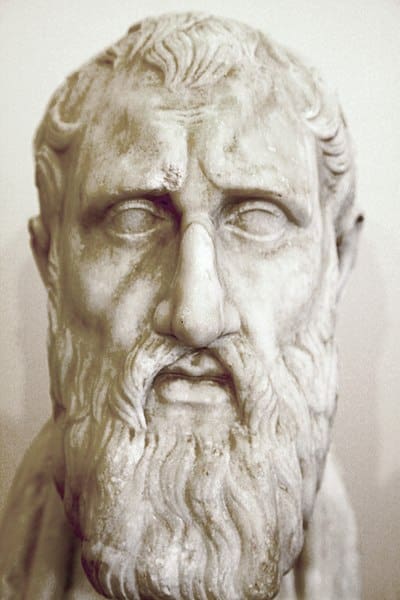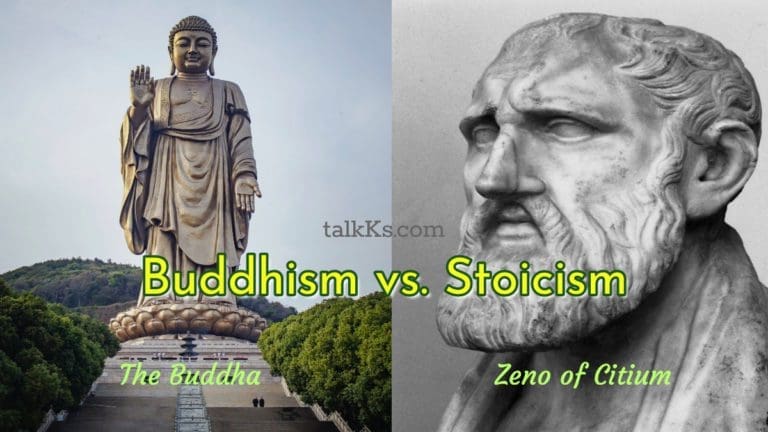Table of Contents
Buddhism and Stoicism are two ancient philosophical traditions that have attracted widespread attention for their practical approach to achieving a happy and fulfilling life. Both these traditions offer unique perspectives on how to find inner peace and meaning in a chaotic and unpredictable world. While there are significant differences between the two, such as their cultural and historical contexts, there are also many striking similarities in their principles and practices. In this article, we will compare Buddhism and Stoicism, and exploring some of the key similarities and differences between them and how they can inform our own search for personal growth and enlightenment.
The Founders of Stoicism and Buddhism
Stoicism and Buddhism originated on other sides of the globe centuries apart. Stoicism was founded by Zeno of Citium in Athens around 300 BCE, while Buddhism was founded by Siddhartha Gautama in modern-day Nepal around 600 BCE.
Zeno of Citium
Zeno, a wealthy merchant, lost his fortune in a shipwreck that left him stranded in Athens, Greece. Despite his misfortune, he is quoted to have remarked, “I made a prosperous voyage when I was shipwrecked.” With no material possessions, he stumbled upon a bookstore and discovered Xenophon’s Memorabilia, which introduced him to the philosophers of Greece. Zeno was greatly inspired by Socrates and inquired with a bookseller about the whereabouts of otherwise individuals like him. The bookseller directed him to the cynic philosopher Crates of Thebes. After a decade of learning, Zeno diverged from cynicism and eventually founded his own school of Stoicism.

The Buddha
Siddhartha Gautama, the founder of Buddhism, was also born into a wealthy family as the son of a king and queen. His birth was accompanied by prophecies of his greatness; some believed he would become a powerful emperor, while others saw him as a potential spiritual leader, provided he left the palace. However, his parents decided to keep him sheltered from the outside world, so they locked him inside the palace. To ensure their son was never exposed to any form of suffering, the king ordered that he be kept away from anything that withered or died. The young prince grew up in a world where all his desires were fulfilled, completely unaware of the existence of pain and suffering.
As time passed, Siddhartha began to hear stories of the world beyond the palace walls. One day, a musician came to the palace and sang about all the wonders of the world, inspiring Siddhartha to embark on a journey to see the kingdom he would one day rule. At the age of 29, he ventured into the world on a chariot accompanied by his charioteer Channa.
According to different versions of the story, Siddhartha’s journey consisted of either four separate journeys or one long journey. Regardless, all versions agree that the young prince underwent a profound transformation after seeing what are called “the foresights.” The first sight was that of an old man, which made Siddhartha realize that all beings eventually age. The second sight was that of a sick person, shocking him, but he soon realized that all beings are subject to sickness and suffering. The third sight was that of a dead body, which overwhelmed Siddhartha with sorrow and sadness. Chana explained to him that death is inevitable and that all living things eventually pass away.
The fourth sight was that of an ascetic who had dedicated himself to finding the cause of human suffering. This gave Siddhartha hope that there was a way out of suffering and a means to be reborn. He embarked on a life of asceticism, depriving himself of all Earthly pleasures.
In his pursuit of enlightenment, Siddhartha Gautama practiced extreme asceticism, which included minimal food intake, different forms of breath control, and forceful mind control. The early texts describe how he became so emaciated that his bones became visible through his skin. However, Siddhartha eventually realized that this extreme form of self-denial was not helping him reach enlightenment.
It was then that he remembered a previous meditative experience he had as a child, sitting under a tree while his father worked. In other versions of the story, he recalls seeing a homeless man meditating. This memory led him to understand that meditation was the path to enlightenment. According to the texts, the Buddha achieved all four meditations, followed by the three higher knowledge, culminating in his enlightenment.

The Magic of Four: The Four Stoic Virtues vs The Four Noble Truths
The Stoics formulated a set of values that embodied the essence of their philosophy, which aimed to help individuals lead meaningful life. These values included four cardinal virtues that served as a guide for living a virtuous life.
- Wisdom – acting rationally and seeing the world with objectivity.
- Justice – treating others with fairness and kindness.
- Courage – being brave when confronted with adversity and understanding that fear can often cause more harm than the thing we are afraid of.
- Temperance – resisting temptations and choosing virtuous actions over vice.
The Stoics believed that living in accordance with these values was equivalent to living in accordance with nature. Just as nature is rational and well-ordered, so are human beings. Therefore, living a virtuous life meant living in harmony with the natural order of the universe.
Epictetus, a prominent Stoic philosopher, emphasized the importance of distinguishing between things we can control and things we cannot. According to him, focusing on the former and letting go of the latter is the key to living a good life.
On the other hand, Buddhists sought to achieve enlightenment or Nirvana by letting go of all attachments and living in the present moment. Unlike the four cardinal virtues of Stoicism, Buddhism promoted the Four Noble Truths developed by the Buddha.
- Dukkha – Life is suffering
- Samudaya – Suffering is caused by attachment and desire
- Nirodha – It is possible to escape the cycle of suffering
- Marga – The Noble Eightfold Path is the way to end suffering
The Eightfold Path is not a straight linear line but rather a middle way, which refers to the way of life between excess and deficiency, also known as moderation. The Noble Eightfold Path includes the following steps:
- Right View: Understanding the Four Noble Truths and the nature of reality.
- Right Intention/Resolve: Developing the intention of non-harming and goodwill towards all beings.
- Right Speech: Speaking truthfully and kindly, avoiding lies, slander, and harmful speech.
- Right Action/Conduct: Acting ethically and avoiding actions that cause harm to oneself or others.
- Right Livelihood: Earning a living in a way that is not harmful to oneself or others.
- Right Effort: Cultivating wholesome states of mind and abandoning unwholesome ones.
- Right Mindfulness: Cultivating awareness and attention to the present moment and avoiding distraction.
- Right Concentration/Samadhi: Developing the ability to concentrate the mind through meditation, leading to deeper insight and understanding.

Nirvana is the ultimate state one reaches when following the Noble Eightfold Path. Nirvana is the state of having no desires and the cessation of suffering. In Sanskrit, Nirvana means “the blowing out,” and it refers to the extinguishing of the flame of personal desire and the quenching of the fire of life. Nirvana is considered the ultimate refuge, providing safety, emancipation, peace, and freedom.
Similarities Between Buddhism and Stoicism
The quest to alleviate suffering lies at the heart of both philosophies, given the harshness of life in the ancient world due to war, famine, and lack of technology. Consequently, ancient thinkers sought ways to reduce suffering and attain a state of calmness and stability. While the Stoics aimed to be like resilient rocks standing firm against the waves of life’s ordeals, Buddha taught resisting carnal desires and pursuing Nirvana, where attachments are severed and suffering extinguished.
After alleviating suffering, how does one attain happiness? Both schools advocate for moderation as the path to happiness. By eliminating excess and focusing on the essential aspects of life, one can experience true satisfaction and harmony.
Buddha expressed this idea by saying, “Temperance is a tree which has for its root very little contentment, and for its fruit calm and peace.”
Both philosophies recognize that happiness is not dependent on pleasure or material possessions. Anxiety, a common source of suffering, is often caused by our obsession with the past or fear of the future. The stoics encourage us to stay in the present moment and tame our minds, while the Buddhists recommend meditation as a way to stay grounded in the present and avoid anxiety. As a famous stoic saying goes, “We suffer more in imagination than in reality.” By letting go of our attachments and focusing on the present, we can find inner calm and peace.
Differences Between Stoicism and Buddhism
At first glance, it may appear that Stoicism and Buddhism share many practical teachings and a similar understanding of the human mind. However, one notable difference is that Buddhism is widely recognized as a religion, while Stoicism is regarded as a philosophy. Around 8% of the world’s population practices Buddhism, but it doesn’t conform to the traditional definition of a religion or a philosophy. Buddhism is non-dogmatic and doesn’t require its followers to worship any supreme deity or creator. Its primary aim is to seek the truth. Unlike Christianity, Buddhism doesn’t have a savior figure, and individuals must find their own path and use the Buddha as a guide rather than blindly following him. Unlike Buddhism, Stoicism is not an organized religion but a philosophical school of thought that anyone can adopt and apply to their own lives. Stoics do not gather in shrines to pray or participate in communal worship, but instead, they share a common bond of spirit and ideology.
Stoicism is widely taught and studied as a philosophy in many universities across the West, while Buddhism has a stronger presence in the East, particularly in countries like India, Japan, China, Myanmar, and others. However, it’s worth noting that many Buddhists also reside in the West, just as stoic ideas are becoming increasingly popular in the East. Despite this, Stoicism remains primarily a Western philosophy, while Buddhism is an Eastern teaching.
Benefits of Living According to Buddhist and Stoic Principles
Living according to either Buddhist or Stoic principles can result in significant psychological benefits. Both practices can lead to a calmer and more serene state of mind and promote spiritual refinement and inner peace.
Stoicism, in particular, emphasizes the importance of personal well-being and a harmonious relationship with society. The philosophy encourages individuals to do the right thing for themselves and for the world at large without expecting any external rewards or validation. Stoics believe that true satisfaction cannot come from external sources and that wisdom and self-improvement are their own rewards. This honest and truthful approach to living can make Stoicism more appealing and attainable in contemporary society. As the world becomes increasingly materialistic and focused on external rewards, the stoic philosophy offers a refreshing alternative that focuses on inner peace and self-improvement.
Marcus Aurelius, the last of the Five Good Emperors of the Roman Empire (Aurelius column), was a Stoic philosopher whose teachings have endured for centuries. His personal diary later published as ‘The Meditations‘ is considered one of the most influential works of philosophy and spirituality. He wrote these personal notes to himself during battles against germanic armies while also suffering from a deadly plague. In these writings, Aurelius offers his stoic views on how to live a good and meaningful life no matter what life throws at you.
If you are distressed by anything external, the pain is not due to the thing itself, but to your estimate of it; and this you have the power to revoke at any moment.
Marcus Aurelius, Meditations
The central concept of all Buddhist teachings is Dharma, which can be translated as truth, reality, or law. The ultimate goal of life is to achieve nobility of the spirit, a form of purity that stems not from a God but from oneself. Dharma exists both in the minds of individuals and as a universal law of righteousness imbued in every aspect of the universe, from the tides of the seas to the changing of the seasons.
Living in accordance with Dharma allows individuals to escape mystery and reach Nirvana, the ultimate release from all suffering. Buddhists believe that through meditation, yoga, and concentration, individuals can train their memory to see their rebirth as a succession of links, even gaining insight into their previous lives.
Furthermore, Buddhism teaches that through enlightenment and true wisdom, individuals can attain Nirvana in this life and eventually arrive at the end of the chain of rebirths.
The Mauryan Emperor Ashoka is one of the most iconic rulers of India’s ancient past. A powerful and ambitious ruler, Ashoka was also a great patron of Buddhism. He converted to the religion following his conquest of Kalinga and went on to become one of its most influential supporters. Ashoka is remembered today for his reforms and the patronage he showed towards Buddhism and its spread across India and beyond. His legacy of peaceful rule stands as an example to the world.
I have enforced the law against killing certain animals and many others, but the greatest progress of righteousness among men comes from the exhortation in favor of non-injury to life and abstention from killing living beings.
Ashoka The Great
Conclusion
Although separated by continents and through Time, Buddhism and Stoicism are remarkably similar as much as they are different. As one Japanese anecdote narrates, Nan-in, a Japanese master during the Meiji era (1868-1912), once welcomed a Western university professor to his temple. The guest was interested in learning about Buddhist practices and sharing his views on the matter. Nan-in served tea to the professor and as he poured, he continued well after the cup was full. The professor grew puzzled at first and then frustrated as he watched the overflow; unable to contain himself any longer, he yelled, “But the cup is overfull and cannot take any more tea!” Nan-in replied, “Like this cup, you too are full of your own opinions and speculations. How can I teach you Buddhism unless you first empty your own cup?” The professor fell silent, and thus his training began.
This story highlights the importance of emptying one’s mind of prejudices and opinions when learning a philosophy, whether from the East or West. It emphasizes the need to focus on the essentials and cultivate dedication to the teachings to become a master of philosophy. However, it also reminds us that everything in life is impermanent, and we should keep this in mind even as we strive to deepen our understanding of philosophy.






Comments 0